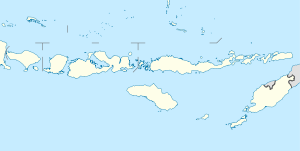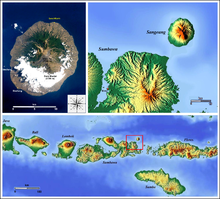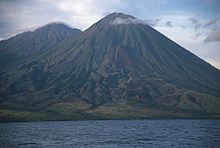Sangeang
| Sangeang | ||
|---|---|---|
| Pulau Sangeang. NASA satellite image immediately after the eruption began in 1985 | ||
| Waters | Lake Flores | |
| Archipelago | Lesser Sunda Islands | |
| Geographical location | 8 ° 12 ′ S , 119 ° 4 ′ E | |
|
|
||
| surface | 153 km² | |
| Highest elevation | Doro Api 1949 m |
|
| Residents | 1700 11 inhabitants / km² |
|
| main place | Gunungapi | |
Sangeang ( Indonesian Pulau Sangeang ) is a volcanic island in Indonesia . It is located about 8 kilometers off the northeast coast of the island of Sumbawa . Administratively, Sangeang belongs to the administrative district ( Kabupaten ) Bima in the east of the province of West Nusa Tenggara .
geography
The almost circular island of Sangeang is about 16 km long in north-south direction and about 13 km wide in west-east direction. Their area is 153 km². It consists of the uppermost area of a volcano rising from the sea floor a total of around 3950 meters, which rises almost 2000 meters from the sea as a complex twin volcano. The island is surrounded by a fringing reef on a base of black sand.
The 1949 m high active volcano Doro Api has built up from andesitic and basaltic lavas within an old caldera , the remains of which can still be seen in the north and west of the island . It is one of the most active volcanoes in the Lesser Sunda Islands . The activities often begin with violent explosions, with which the older magma masses are blown away on the summit . It is not uncommon for glowing clouds to descend. This is followed by a strombolian activity that often lasts for months . The lava emerging at the end of each eruption fills the chimney again until it overflows and prevents the formation of a sunken summit crater. Intermittent plumes of steam occur during breaks.
From 1512 to the last known activity in 2018, a total of 20 outbreaks were registered with increasing frequency. One of the most violent outbreaks began in 1985. Within a month, the 1250 residents were evacuated to Sumbawa. In a wide channel on the western slope of the volcano, which can be clearly seen on the satellite image, glowing clouds and lava flows descended into the valley. The outbreak lasted until 1988.
Another of the most violent eruptions began on May 30, 2014. The ash cloud that formed in the course of the following days rose to a height of 20 kilometers and drifted over 3000 kilometers east and southeast, causing air traffic in eastern Indonesia and northern Australia to be temporary set. After the collapse of a lava column, clouds of fire went down into the valley; one of these clouds of embers poured into the sea. On June 17, 2014, the security level was reduced from 3 (from a maximum of 4) to 2.
On the southern flank of Doro Api rises the older 1795 m high, extinct Doro Muntai, who in turn has a small side crater about halfway up the southern slope. There is also a small adventitious cone not far from the north coast.
Climate and vegetation
Climatically, the island suffers from the dry east monsoon. Similar to the east of Sumbawa and on the islands between Sumbawa and Flores (including Komodo and Rinca ), savannah-like grassy areas with shrub growth spread out in the hot and dry coastal areas. In the higher altitudes, insofar as these have been spared volcanic effects, a belt of mountain forests stretches around the bare peaks, which only extends into lower regions in some valleys.
population
The number of residents living on Sangeang is estimated at around 1700. Most of them are descendants of immigrant Bugis from South Sulawesi . Because of the increasingly violent volcanic eruption that began in 1985, they were evacuated to the neighboring island of Sumbawa at the beginning of 1986 by order of the government. A new village was built for the total of 286 families, which was named Sangeang Darat (“Darat” means “land”). Each family received one hectare of land. After the end of the volcanic eruption, returning to Sangeang was prohibited for safety reasons. However, many families returned to Sangeang to tend their livestock and gardens.
The only significant settlement on Sangeang is a small village on the west coast, which is shown in older maps from the Dutch colonial era with the name Gunungapi ("volcano"). The coastal village of Bontoh, consisting of primitive huts, is drawn in high-resolution satellite images on the southwest coast . Only here can you see modest farming, divided into small fields. There is a barter with the island of Sumbawa, in which mainly rice and sugar are imported. The name Gunungapi is currently no longer mentioned. The interior of Sangeang is uninhabited.
Tourism is a modest source of income, but it is only practiced by individualists: Sangeang is a paradise for divers. Tour operators emphasize the contrast between intact coral reefs with colorful marine animals and the underground of dark volcanic sand. Divers have reported spots of escaping gas bubbles and submarine hot springs that would warm the water in the area to 37 to 39 ° C. Accommodation options are only available in Bontoh.
literature
- RDM Verbeek: Moluccas Lagoon . Jaarboek van het Mijnwezen in Nederlandsch Indie, Vol. 37, Wetenschappenlijk gedeelte, p. 572. Batavia 1908.
- J. Elbert: The Sunda Expedition . Volume II, pp. 138-139. Frankfurt a. M. 1912.
- H. Ehrat: The active volcanoes of G. Api (Sangean) near Bima (Dutch India) . Zeitschrift für Vulkanologie, Volume 12, pp. 8-14. Berlin 1929.
- M. Neumann van Padang: Catalog of the active volcanoes of Indonesia. Pp. 167-169. Napoli 1951.
- Lindsay McClelland, Tom Simkin, Marjorie Summers, Elizabeth Nielsen, and Thomas C. Stein (ed.): Global Volcanism 1975-1985. Prentice Hall, Englewood Cliffs NJ, and American Geophysical Union, Washington DC. pp. 657. Smithsonian Institution / SEAN (1989). ISBN 0-13-357203-X .
Individual evidence
- ^ Atlas van Tropisch Nederland, page 27
- ↑ also called Gunung Api ("fire mountain", thus "volcano") or Sangeang Api
- ↑ Andesitic lavas with inclusions of diorites and granodiorites , also made of pure olivine basalt and olivine basalt with andesites; see. Ehrat (1929), Verbeek (1908), Elbert (1912)
- ↑ Also in 1512 a volcano erupted on the East Indonesian island of Wetar . The news of this eruption and the report on the eruption of the volcano on Sangeang that same year are the earliest records of volcanic eruptions made by Europeans in the area of what is now Indonesia.
- ↑ See [1]
Web links
- Sangeang in the Global Volcanism Program of the Smithsonian Institution (English)
- Youtube video of the Hot Rocks Sangeang Volcano (diving area)




